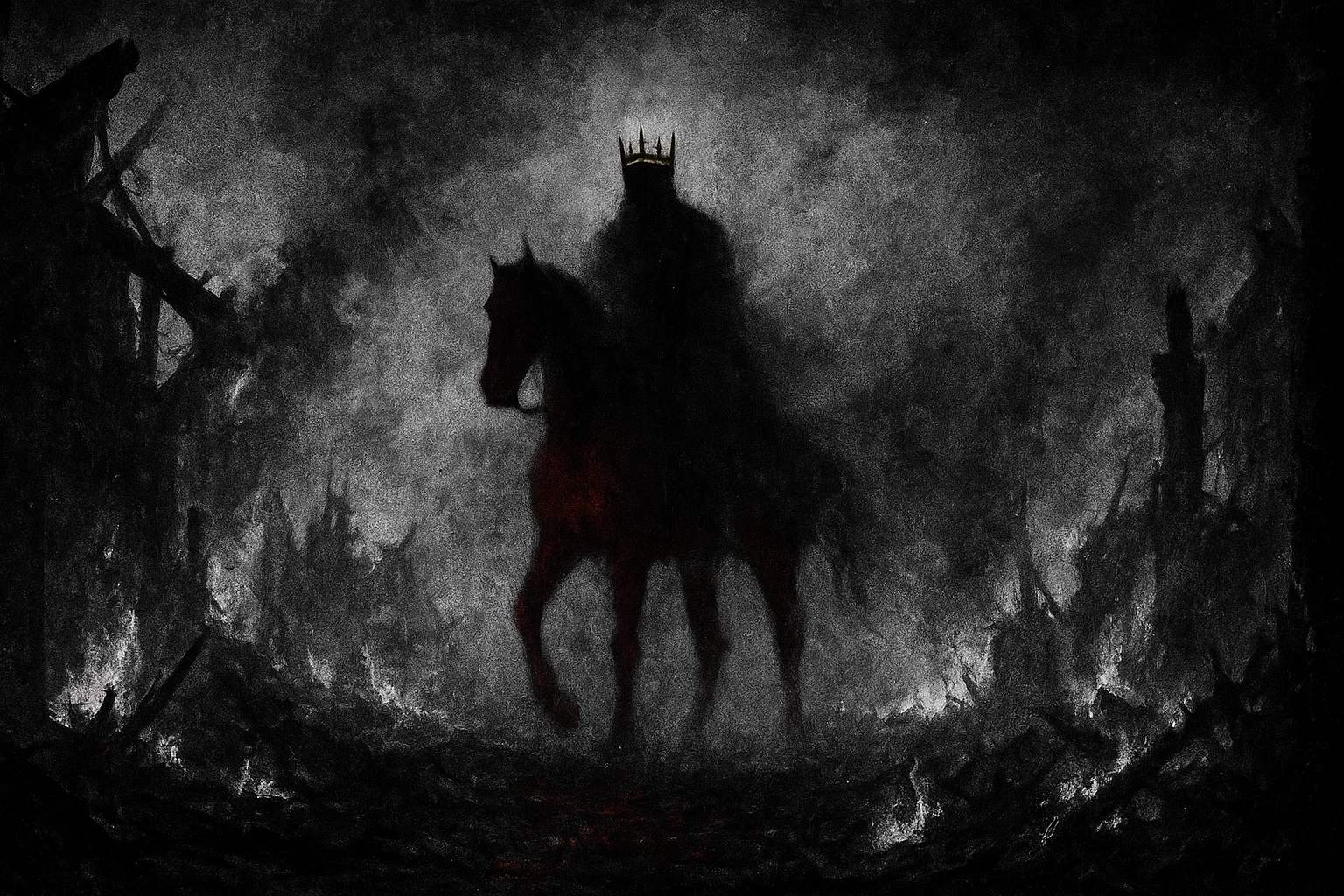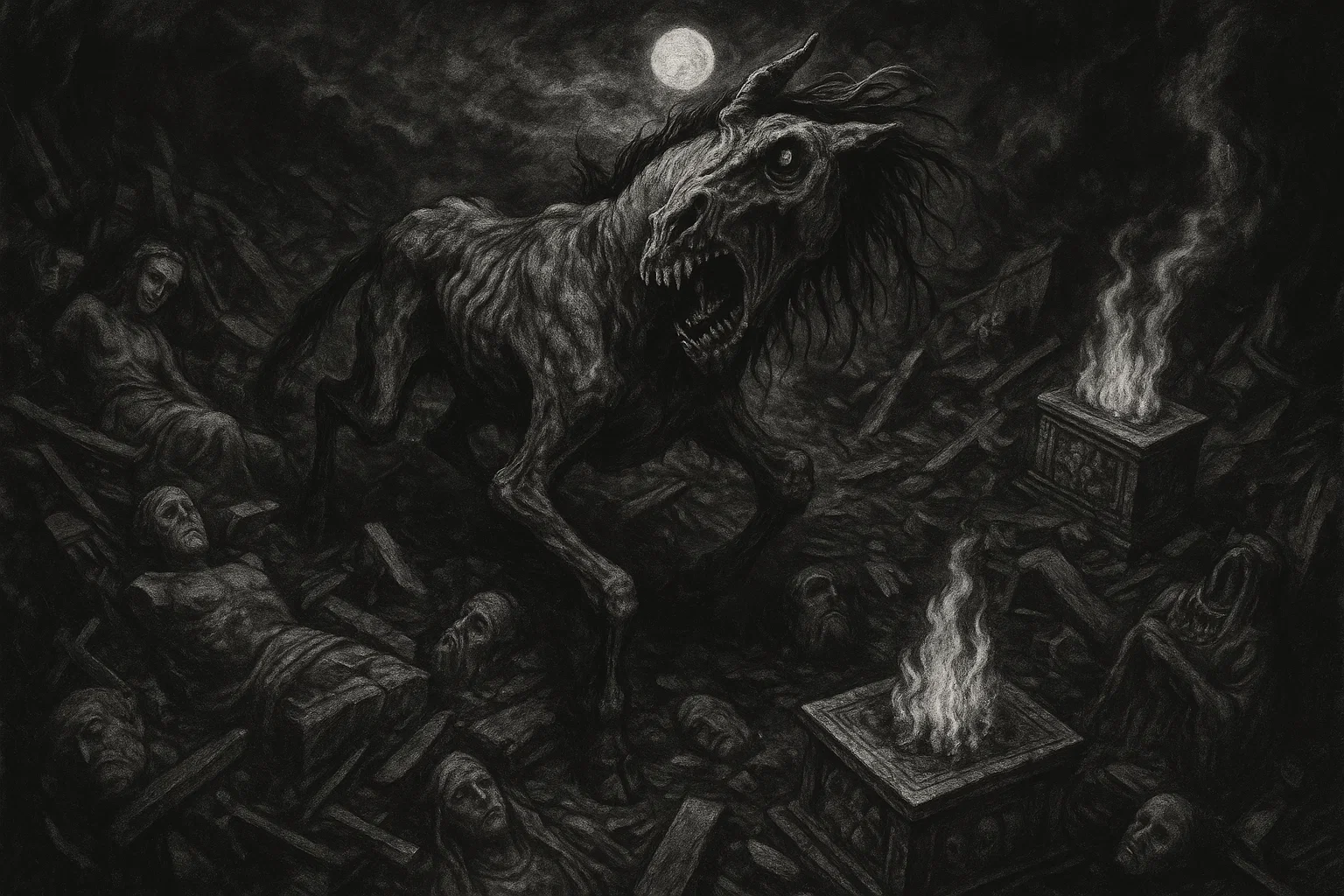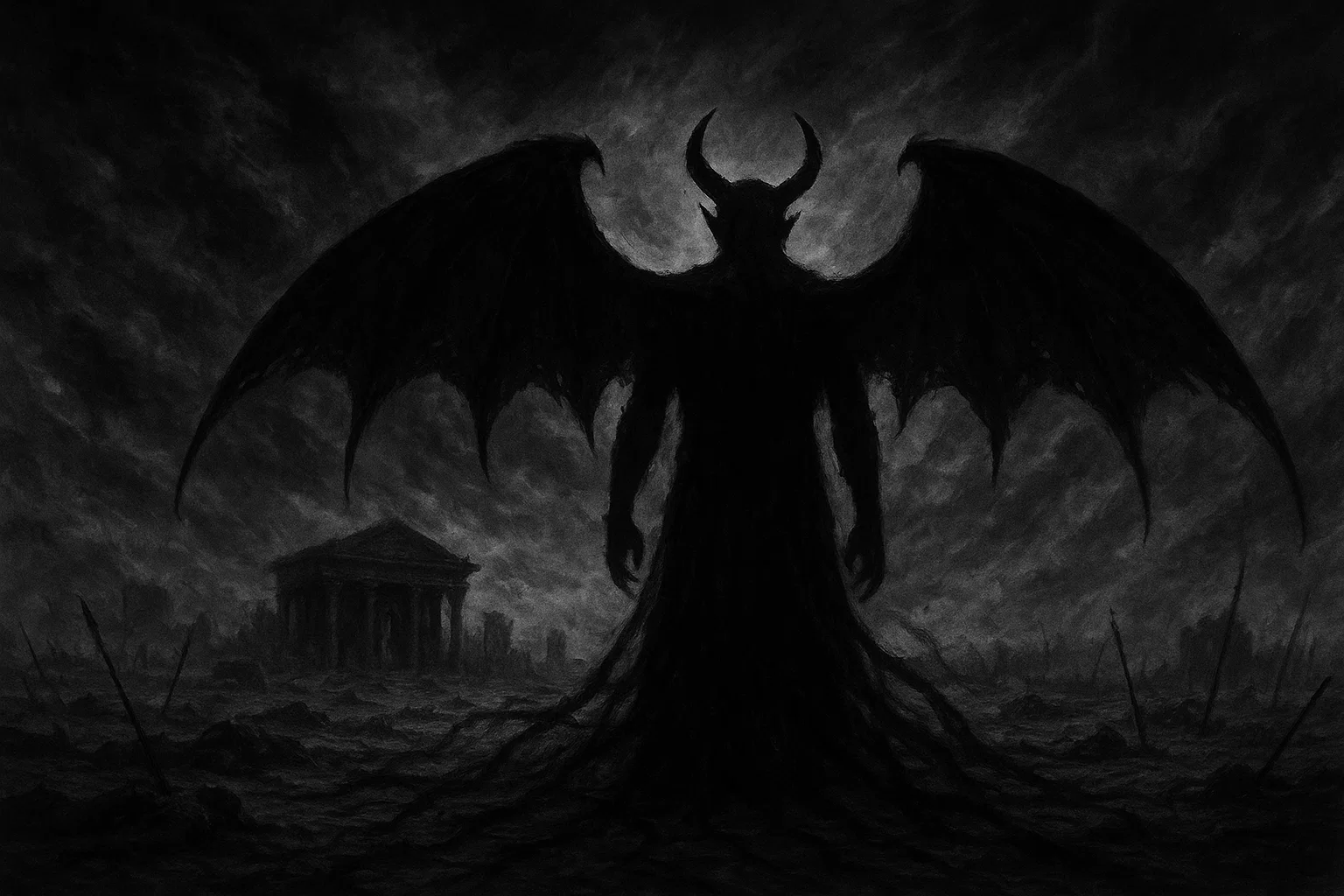In the shadowed realms of demonology, where forbidden passions ignite and twist into chains of despair, Zepar emerges as a malevolent force of seduction and ruin. This demon, a master of lustful manipulations, preys on the vulnerabilities of the human heart, turning fleeting desires into lifelong curses.
What if a single invocation could spark an all-consuming love, only to shatter the dreams of legacy and fertility? How does one navigate the treacherous line between attraction and annihilation when dealing with such an entity? Could the pursuit of romantic conquest lead not to fulfillment, but to eternal barrenness and regret?
These questions haunt the lore surrounding Zepar, a duke in the infernal hierarchy whose influence embodies the darkest aspects of affection—deceptive, destructive, and utterly devoid of mercy.
Table of Contents
Key Information
To fully grasp the menacing nature of Zepar, the demon of lust and infertility, consider the following essential details drawn from ancient demonological texts and infernal hierarchies.
| Attribute | Details |
|---|---|
| Name | Zepar, also known as Zephar, occasionally conflated with Vepar or Separ in various demonological manuscripts due to linguistic evolutions and scribal errors |
| Title | Great Duke of Hell, Grand Duke of the Infernal Realms, Duke of Deceptive Passions |
| Gender | Male, though some depictions incorporate ambiguous or androgynous traits to symbolize his manipulative fluidity in seduction |
| Role | Demon specializing in lust, seduction, sodomy, pederasty, and corrupted romantic unions; he facilitates deceptive relationships while inflicting infertility and emotional ruin |
| Hierarchy | Ranked as the 16th spirit among the 72 demons in Solomonic traditions; serves as a duke in the infernal order, commanding legions focused on emotional manipulation |
| Servitors | Commands 26 legions of inferior spirits, with some variant sources suggesting up to 28; these legions aid in spreading illusions of love and enforcing curses of barrenness |
| Superior Demon | Answers to Corson, one of the four principal kings of Hell who oversees the 72 bound demons; Corson’s authority emphasizes Zepar’s position in the broader demonic chain of command |
| Powers | Inflames women with unnatural love for men, unites couples in illusory bonds, renders women barren to extinguish lineages, masters shape-shifting for seduction, excels in illusionary magic, alchemy for transforming realities, military strategy for conquering hearts, spying to exploit vulnerabilities, troubadouring to weave enchanting deceptions, merchandising false promises, and assassination of fidelity and trust |
| Appearance | Manifests as a soldier in vivid red armor and apparel, evoking bloodshed and unbridled passion; features may include a phallic-shaped head, vulva-like slits for ambiguity, a clubfoot symbolizing imbalance, a slight yet imposing build, a dark and contemptuous expression, and a grating, metallic voice that chills the soul |
| Etymology | Rooted in Hebrew “זאפר” (zĕphâr), linked to “he-goat” as a symbol of rampant lust, or concepts of “separation” and “division,” reflecting his ability to sever fertility and fracture relationships |
| Associated Figures | Connected to Lilith as a familiar in succubi legends, Furfur in twin-like deceptive adaptations, Gamori in themes of perverted affection, and other lust demons like Sitri and Sallos for collaborative corruptions |
| Weaknesses | Susceptible to invocations of the opposing angel Hakamiah, who counters treasonous desires; vulnerable to holy symbols, banishment rituals, salt barriers, and moral fortitude that resists his temptations |
| Opposing Angel/Saint | Hakamiah, the Kabbalistic angel governing loyalty and truth, directly opposing Zepar’s deceitful influences |
| Equipment/Tools | Wields venom-smeared weapons that cause scarring wounds healable only by esoteric means; employs ritual sigils for summoning, mandrake roots for inverted fertility curses, and illusory tools like dream sorcery devices |
| Pantheon | Primarily featured in Christian demonology, Solomonic grimoires, and Judeo-Christian infernal traditions, with echoes in broader occult hierarchies |
Etymology of Zepar: Division and Lustful Symbolism
The name Zepar, a cornerstone in demonology, carries layers of sinister meaning derived from ancient linguistic traditions. Primarily traced to Hebrew origins as “זאפר” (zĕphâr), it evokes the image of a “he-goat,” an animal long associated with unbridled lust, virility, and chaotic impulses in biblical and mythological contexts.
In ancient Semitic cultures, the he-goat symbolized fertility gone awry—rampant, uncontrolled desires that lead to destruction rather than creation. This etymological link aligns perfectly with Zepar’s demonic role, where he inflames passions only to curse them with barrenness, separating lovers from the natural fruits of their unions.
Scholars of occult linguistics speculate further connections to Hebrew terms for “separation” or “division,” such as roots akin to “zapar” meaning to split or sever. This interpretation reflects Zepar’s ability to create rifts in relationships, dividing fertility from affection and sowing discord in what should be harmonious bonds.
In broader Semitic languages, similar phonetics denote rebellion or revolt, tying into Zepar’s astrological associations with treason and upheaval.
For instance, in Aramaic influences, words resembling “zepar” imply a disruptive force, much like how Zepar disrupts natural orders by rendering women infertile amid deceptive romances.
Historical grimoires, such as the Pseudomonarchia Daemonum, reinforce these roots by portraying Zepar as a divider of futures, where his name becomes synonymous with the corruption of purity.
Variations like Zephar or conflations with Vepar (a separate demon of stormy seas) highlight evolutionary shifts in nomenclature across medieval texts, possibly due to scribal interpretations or regional dialects.
Some occult etymologists draw parallels to ancient Mesopotamian concepts of goat-like spirits, akin to the capricious entities in Babylonian demonology that embodied lustful chaos. Others link it to Greek influences, where “zephyros” (west wind) suggests illusory winds of change, mirroring Zepar’s mastery over deceptive illusions.
In Kabbalistic traditions, Zepar’s name resonates with themes of imbalance in the Tree of Life, particularly in spheres related to desire (Netzach) and severity (Gevurah), where separation from divine harmony leads to infernal corruption.
This etymological depth underscores Zepar as a corrupter, eternally dividing the sacred from the profane in human desires. Exploring these roots reveals how Zepar’s name encapsulates his essence—a demon whose very moniker warns of the perils in pursuing lust without consequence.
You May Also Like: The Portrait of Doña Isabel de Porcel Curse: Real or Not?
What Does the Demon Zepar Look Like?
Zepar’s manifestation strikes terror and fascination, embodying the dual horrors of warfare and warped desire. He appears as a formidable soldier clad in crimson armor and apparel, the red hue symbolizing not just passion but the bloodshed of betrayed hearts and ruined lineages.
This warrior-like form, complete with imposing pauldrons and a helmet that accentuates his dark mien, evokes the intensity of battlefields where conquests are won through deception rather than honor. His build is slight yet sinewy, suggesting agility in manipulation over brute force, allowing him to slither into the minds of his victims like a venomous serpent.
Ambiguous traits further distort his appearance, blending masculine aggression with grotesque feminine elements—a phallic-shaped head juxtaposed with vulva-like slits, creating a nightmarish harmony that mocks natural gender boundaries. This androgyny serves his seductive purposes, enabling shape-shifting into forms that exploit vulnerabilities.
A clubfoot mars his stance, symbolizing the imbalance he inflicts on relationships, while his expression is one of contemptuous scorn, eyes burning with infernal disdain. His voice grates like rusted metal on stone, a sound that echoes the grinding destruction of trust and fertility.
In variant depictions from occult manuscripts, Zepar may wield venom-coated weapons, their blades dripping with curses that scar both body and soul. His dark skin and shadowed features enhance the aura of mystery, making him a figure that lurks in the periphery of visions, ready to pounce on unsuspecting desires. This appearance not only terrifies but also lures, as Zepar uses his martial allure to disguise the ruin he brings.
Zepar’s Historical and Mythological Background
Zepar’s origins plunge deep into the abyss of fallen angel lore, where he once served in celestial ranks before rebelling alongside Lucifer during the War in Heaven. Cast down for his defiance, he transformed into a duke of Hell, bound by King Solomon as one of the 72 spirits in Solomonic traditions.
Rooted in Judeo-Christian demonology, Zepar’s background blends with alchemical deceptions and illusory arts, making him a subtle manipulator rather than a brute force demon. His story draws from ancient grimoires, where Solomon compelled him to reveal secrets of lust and infertility, using his powers against humanity’s foes but warning of his corrupting nature.
Mythologically, Zepar’s legends center on insidious seductions that lead to tragedy. In one apocryphal tale from medieval occult adaptations, Zepar infiltrates a king’s court, inflaming the queen with lust for a lowly knight.
Their union, facilitated by Zepar’s illusions, results in barrenness, causing the kingdom’s lineage to fail and plunging the realm into civil war—a divine punishment manifested through demonic means.
Another legend portrays Zepar as a dream sorcerer, appearing in visions to seduce women, binding their souls in chains of passion only to curse them with infertility, extinguishing family lines as revenge against mortal hubris.
Connections to other deities and demons span cultures. In Hebrew traditions, Zepar parallels Azazel, the fallen angel who taught humanity forbidden arts, including seduction techniques that corrupted societies. Semitic links tie him to Baal or Astarte’s lustful aspects, demonized in Christian texts as entities promoting barren unions.
Globally, Zepar echoes Hindu asuras like Raktabija, whose blood spawns more demons, symbolizing endless corruption from desire.
In Greek mythology, he resembles Eros gone malevolent, shooting arrows of lust that wound rather than unite. Egyptian parallels include Set, the god of chaos and sterility, whose disruptions mirror Zepar’s severance of fertility.
In Babylonian lore, Zepar connects to Lilu or Ardat Lili, night demons causing infertility, akin to his association with Lilith. As her familiar in some narratives, Zepar aids in succubi seductions, preying on youths through pederasty or sodomy, leading to extinct bloodlines.
A specific myth involves Zepar allying with Furfur, a storm demon, to create tempests of emotion that drown lovers in despair. Interactions with superiors like Corson see Zepar executing orders of widespread corruption, while adversaries such as Hakamiah thwart his plans with divine loyalty.
European folklore adapts Zepar into tales of cursed lovers, where villagers summon him for romantic aid, only to face villages depopulated by infertility plagues.
In African diasporic traditions, he parallels trickster spirits like Legba, but with a darker edge of sexual deception. Asian connections include Japanese yōkai like the Jorōgumo, spider demons seducing men to ruin, reflecting Zepar’s web of illusions. These global ties illustrate Zepar’s archetype as a universal corrupter of desire, narrating stories where his interventions always end in isolation and loss.
You May Also Like: Was Manuel Blanco Romasanta Really a Werewolf?
The Demon Zepar’s Seduction Legends
Legends of Zepar abound with narratives of seduction turning to sorrow. In a prominent story from occult compilations, Zepar is summoned by a desperate nobleman seeking his rival’s wife’s affection.
Zepar obliges, shape-shifting to mimic the husband and enflaming her lust, but the resulting union bears no fruit, leading to accusations of witchcraft and the nobleman’s execution.
Another tale depicts Zepar as a troubadour in medieval courts, singing ballads that weave spells of desire, causing queens to abandon thrones for illicit lovers, only for their wombs to wither, symbolizing the fall of empires through personal vice.
In interactions with Lilith, Zepar facilitates nocturnal visits, where succubi drain life forces while he ensures barrenness, perpetuating cycles of demonic reproduction over human.
A fictional yet lore-inspired myth has Zepar clashing with Saleos, another love demon, over a mortal’s soul—their rivalry resulting in a barren wasteland where once-fertile lands stood, a metaphor for jealousy-fueled destruction.
Associations with Lilith and Forbidden Unions in Demonology
Zepar’s ties to Lilith amplify his malevolence, positioning him as her aide in corrupting humanity. In legends, Lilith, the first wife of Adam turned demoness, employs Zepar to target patriarchal lineages, rendering women barren as vengeance against divine orders.
One story recounts Zepar inflaming a priest’s forbidden lust for a nun, their union cursed with infertility, leading to madness and the church’s downfall. These associations highlight Zepar’s role in forbidden pacts, where allies like Gamori join to pervert love into prostitution-like deceptions.
Global parallels include connections to Aztec Xochiquetzal, goddess of love demonized as a barren temptress, or Norse Freyja’s darker aspects in seidr magic that twists fates. Zepar’s myths consistently narrate interactions where he corrupts heroes, villains, and innocents alike, always leaving trails of divided families and shattered dreams.
You May Also Like: The Village of Starving Souls | Horror Story
Historical Mentions in Grimoires and Texts
Zepar’s presence in historical demonology is documented across key texts, each adding layers to his malevolent profile.
| Text/Grimoire | Year | Description | Excerpt |
|---|---|---|---|
| Pseudomonarchia Daemonum | 1577 | Portrays Zepar as a great duke appearing as a soldier; he inflames women with love for men, alters their shapes for seduction, renders them barren, and commands 26 legions | “Zepar is a great duke, appearing as a souldier, inflaming women with the loove of men, and when he is bidden he changeth their shape, untill they maie enjoie their loove; he also maketh them barren, and six and twentie legions obeie him.” |
| Ars Goetia (The Lesser Key of Solomon) | 17th century | Describes him as a Great Duke in red apparel and armor like a soldier; causes women to love men, unites them deceptively, makes them barren; governs 26 legions | “The Sixteenth Spirit is Zepar. He is a Great Duke, and appeareth in Red Apparel and Armour, like a Soldier. His office is to cause Women to love Men, and to bring them together in love. He also maketh them barren. He governeth 26 Legions of Inferior Spirits…” |
| Dictionnaire Infernal | 1818 | Depicts Zepar as a grand duke of hell appearing as a warrior; brings love of women to men, causes death of husbands; possibly linked to Vepar | “Zepar or Vepar, grand duke of hell, appears in the form of a warrior; he brings to men the love of women, and causes the death of husbands.” |
| Munich Handbook of Necromancy | 15th century | References entities with similar traits, focusing on lust induction and infertility curses | Variations describe spirits altering forms for seduction and enforcing barrenness through venomous influences. |
| Grand Grimoire | 19th century | Mentions Zepar in hierarchies, emphasizing his role under kings like Corson in manipulative arts | Alludes to dukes like Zepar commanding legions for emotional assassinations and deceptive unions. |
Zepar’s Powers and Abilities: Mastery of Deception and Ruin
Zepar’s powers distinguish him as a specialist in emotional corruption, targeting romantic bonds with precision that generic demons lack. He inflames women with overwhelming lust for men, forging unions doomed to tragedy through illusions and alchemical alterations.
Unlike broad tempters, Zepar exploits specific vulnerabilities, using dream sorcery to invade minds and bind souls in passion’s grip. His military expertise strategizes heart conquests, while spying uncovers secrets for exploitation. Venomous weapons symbolize betrayals that scar eternally, healable only by rare magic.
In pop culture adaptations, such as video games and stage plays, Zepar gains newer abilities like enhanced illusionary storms or soul-binding pacts, expanding his arsenal in modern interpretations.
For instance, in certain role-playing narratives, he manipulates timelines to rewind failed seductions, ensuring ruin. These evolve from traditional powers, blending with contemporary demonology.
| Power/Ability | Description | Source | How It Tempts/Corrupts Humans | Countermeasure |
|---|---|---|---|---|
| Lust Inducement | Inflames women with deep, unnatural love for men, uniting them in deceptive bonds | Ars Goetia, Pseudomonarchia Daemonum | Preys on isolation, fostering obsessions that ignore infidelity, leading to madness and societal ruin | Invoke Hakamiah for loyalty; use fidelity rituals and grounding herbs like sage |
| Infertility Curse | Renders women barren, preventing conception and extinguishing lineages | Ars Goetia, Dictionnaire Infernal | Sows despair in legacy-seekers, turning joy to sorrow and fracturing families | Fertility prayers to opposing forces; Hakamiah’s balance-restoring invocations |
| Shape-Shifting Deception | Alters forms to enable seduction, mimicking beloved figures | Pseudomonarchia Daemonum | Erodes trust through false intimacies, corrupting self-identity and moral foundations | Banishing circles with holy water; Hakamiah for truth revelation |
| Illusionary Magic and Alchemy | Creates deceptions and transforms realities to mask vices | Occult adaptations, modern grimoires | Warps perceptions, making corruption appear desirable, accelerating moral decay | Angelic clarity meditations; grounding with earth elements |
| Military Strategy and Assassination | Applies warfare tactics to emotional conquests, using venom for scarring | Demonological expansions | Tempts ambitious individuals into subtle manipulations, assassinating relationships | Protective amulets; warrior angel invocations like Michael |
| Dream Sorcery | Invades dreams to seduce and control emotions | Variant legends, pop culture references | Binds victims in subconscious chains, leading to waking obsessions and ruin | Salt barriers around beds; sage smudging to disrupt nocturnal influences |
| Spying and Intelligence | Uncovers hidden weaknesses for targeted corruption | Infernal hierarchy details | Exploits secrets to blackmail or manipulate, deepening cycles of deceit | Privacy wards; invocations for mental shielding |
| Troubadouring Enchantments | Weaves songs or tales to enflame desires | Mythological extensions | Lures through artistic deceptions, corrupting cultural or personal narratives | Counter with truthful hymns; angelic harmonies |
You May Also Like: The Demon Furfur – Powers, Weaknesses, and Sigil Meaning
How to Counter Zepar’s Powers
Countering Zepar demands unyielding vigilance and spiritual armor against his illusions. Begin with fortifications like prayer circles etched in salt, repelling his dream sorcery and grounding victims in reality. Invoking Hakamiah is crucial, as this angel of loyalty pierces Zepar’s deceptions with divine truth, countering treasonous passions.
For infertility curses, employ fertility rites involving earth elements or opposing saints, restoring balance disrupted by Zepar’s touch. Awareness of his grating voice and red visage aids detection, enabling swift banishment via Solomonic seals inscribed on parchment.
Moral resolve—rejecting vainglorious temptations—proves paramount, as Zepar thrives on weak wills. Combine angelic aid with personal strength to neutralize his grasp, using amulets of copper (his associated metal) charged with protective incantations.
In cases of shape-shifting, holy water sprinkled in ritual patterns reveals true forms, while sage smudging clears illusory fogs. For those afflicted by his legions, mass banishments invoking higher hierarchies like Corson can disrupt commands. Ultimately, education in demonology—recognizing signs of Zepar’s influence like sudden obsessions or unexplained barrenness—prevents summons altogether.
Zepar’s Role in the Hierarchy of Hell
Within Hell’s rigid structure, Zepar holds the rank of Great Duke, as outlined in Ars Goetia and related texts. This mid-tier nobility places him below kings like Corson, to whom he reports, and above lesser spirits. Dukes like Zepar oversee specialized domains—his being the corruption of love—distinguishing him from broader tyrants.
Zepar rules over a desolate region in Hell’s lower circles, a barren wasteland echoing his infertility curses, where twisted spires resemble phallic symbols amid crimson storms.
His armies, 26 legions strong, consist of illusory warriors and seductive imps skilled in emotional sabotage. Notable subordinates include lesser demons like Zephyron (a wind spirit for dream infiltration) and Inferna (a barrenness enforcer), executing his commands with ruthless efficiency.
Superiors beyond Corson include Lucifer, who deploys Zepar for hazardous missions like infiltrating mortal hearts or clashing with angels. Allies comprise fellow dukes like Sitri (mutual love corrupter) and Gremory (women’s love procurer), collaborating on mass deceptions. Adversaries include Hakamiah and rival demons like Asmodeus, whose marriage-destroying powers spark territorial feuds.
Zepar’s unruly legions suggest strained dynamics, yet he maintains alliances through shared vices, conducting espionage and seduction operations.
Astrological Associations and Symbolism
Zepar’s astrological links bind him to Venus, the planet of love and beauty, but twisted into revolt and disruption. His zodiac placement in Gemini (15-19 degrees, June 6-10) evokes duality, mirroring his ambiguous form and shape-shifting deceptions. Elements of earth (grounded passions) and air (illusory winds) dominate, representing stable yet fleeting corruptions.
Symbolism includes colors like red for lustful fury and green for Venusian decay, metals such as copper for conductive energies, and crystals like emerald for disrupted harmony or rose quartz for false affections. Planets Venus and Mercury amplify his mercurial manipulations, while numbers 16 (Goetia rank) and 26 (legions) hold numerological weight for invocations.
| Association | Details |
|---|---|
| Planet | Venus (primary for desire), Mercury (secondary for deception) |
| Element | Earth (stability in corruption), Air (winds of illusion) |
| Zodiac | Gemini (duality and change), influences from Scorpio for hidden passions |
| Numbers | 16 (hierarchical position), 26 (legion command), 7 (days for rituals) |
| Days | Friday (Venus-ruled), daytime for maximum deceptive power |
| Metals | Copper (conducts lustful energies), iron (for venomous weapons) |
| Precious Stones/Crystals | Emerald (Venus harmony twisted), rose quartz (false love), obsidian (protection against his illusions) |
| Colors | Red (passion and blood), Green (growth stunted), Black (infernal mystery) |
| Tarot | Lovers (reversed for corrupted unions), 9 of Swords (despair from desires) |
| Incense | Sandalwood (purifies deceptive desires), mandrake (inverts fertility) |
| Herbs/Plants | Mandrake root (lust curses), nightshade (illusions), venus flytrap (trapping passions) |
You May Also Like: The Demon Räum in Ars Goetia: What You Need to Know
Zepar’s Sigil: Emblem of Virility and Corruption
Zepar’s sigil, a potent glyph in Goetia, resembles testicles twisted into infernal curves, symbolizing dominion over sex and its denial.
Inscribed on parchment or amulets, it compels his obedience during summons, channeling energies for lust spells. Its design evokes alchemical transformation, used in meditations to ignite illusions or barren curses. Rituals involve carving it on black candles, amplifying his presence while risking backlash if disrespected.
| Symbol/Item | Association/Meaning | Use in Rituals |
|---|---|---|
| Sigil | Virility corrupted; testicle-like form | Inscribed for summons; focus for love deceptions or shape changes |
| Red Armor | Warfare in desire, passion’s bloodshed | Visualized for lust rites; red candles as offerings |
| Copper Talisman | Venusian conductivity, energy flow | Bowls for offerings; enhances illusion spells |
| Mandrake Root | Inverted fertility, chaotic lust | Placed on altars for barrenness curses; potions for dream sorcery |
| Sandalwood Incense | Purification twisted into deception | Burned to attract Zepar; clears space for seductive energies |
| Rose Petals | Fleeting beauty of corrupted love | Scattered as offerings; symbolizes temporary, doomed unions |
| Black Candle | Infernal mystery and power | Lit in daytime rituals; carved with sigil for passion ignition |
| Venomous Dagger | Scarring corruption, emotional wounds | Symbolic in curses; represents assassination of trust |
| Emerald Crystal | Disrupted harmony, false affections | Held for grounding against madness; amulets counter barrenness |
| He-Goat Symbol | Lustful virility and rebellion | Evoked in etymological rites; symbolic for strength in manipulation |
Zepar in the Infernal Pantheon
Zepar’s unique blend of seduction and sterility sets him apart in demonology. The table compares him to similar entities, highlighting differences in hierarchy, powers, and appearances.
| Demon | Hierarchy | Powers | Appearance |
|---|---|---|---|
| Sitri | Great Prince | Incites mutual love, reveals secrets, strips dignity | Leopard face with griffin wings, transforms to beautiful man |
| Saleos | Great Duke | Induces inter-sex love, promotes false peace | Handsome soldier on crocodile, ducal crown |
| Asmodeus | King | Destroys marriages, incites lust, teaches forbidden arts | Three-headed (bull, man, ram) on dragon with serpent tail |
| Astaroth | Duke | Answers queries on time, teaches sciences, leads to treasures | Foul angel on infernal dragon with viper |
| Gremory | Duke | Procures women’s love, reveals treasures and fates | Beautiful woman on camel, ducal crown |
| Furfur | Earl | Causes marital love, summons storms, teaches secrets | Hart with fiery tail, angelic transformation |
| Belphegor | Prince | Aids inventions, sows discord via sloth | Horned demon on toilet, embodying laziness |
| Marchosias | Marquis | Fierce fighter, truthful answers, hopes for heaven return | Wolf with gryphon wings, serpent tail, fire-spitter |
Conclusion
Zepar’s insidious presence in demonology epitomizes the dangers of desire, where infernal flames consume rather than comfort. As a duke mastering hearts’ corruption, he warns of the fragile veil between affection and ruin, urging wariness in occult explorations.
His tales, from ancient grimoires to modern adaptations, reflect humanity’s frailties, challenging us to confront cravings with resolve. Zepar stands as a dark testament to demonology’s depths, a corrupter whose dance of passion and peril endures eternally.







